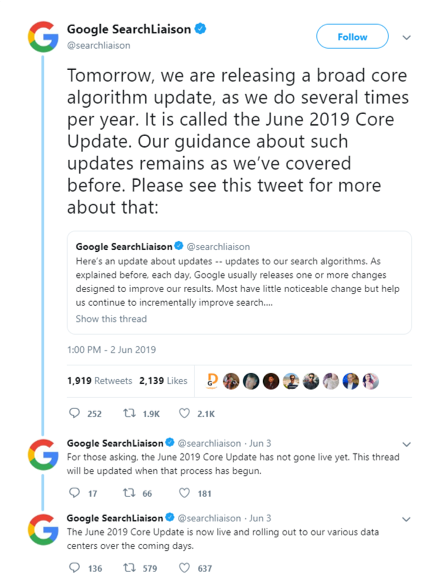What We Know About The Latest Update
On June 2nd, through Google SearchLiaison’s Twitter account, Google announced they’d be rolling out a broad core quality update. In typical Google fashion, any specifics about the update were bleak and non-existent. On June 3rd, the update began to roll out and confirmation came out on June 8th that the update had fully been rolled out. As many of us webmasters anticipated completion of the rollout, we waited anxiously to see what impacts this update had.

Before we get any further and dive into the potential impacts this update has in store, let’s back up for just a second. Yes, it is ever so sweet of Google to let us know that an update is happening. However, for webmasters and content providers, it is difficult to anticipate, measure, and potentially do anything regarding a broad core algorithm update. On top of that, when an update has a negative impact on our properties, we’re left wondering: What do we do about it and why did Google do that?
In general, however, if you follow best practices for inbound marketing, you should not have to worry about much when these algorithm updates happen. Typically, it’s more of a gut check to ensure you’re following best practices and providing top quality content and experience for users.
According to John Mueller during a webmaster hangout, when Google pushes a broad core update, the overall guidance is that there is nothing to fix or change with the update. The updates encompass a “broader range of factors.” Google does provide some guidance regarding content if your website is impacted in a negative way, namely:
This type of broad category update isn’t the only one Google springs on us. Google also updates for specific issues, such as mobile-first indexing or page load speed. When those types of updates go through, webmasters can typically address them appropriately with changes to the web properties they work on.
Now, let’s circle back and take a look at the impacts we investigated from this latest update. After gathering data from our client's websites and from what we’ve heard from others in different industries, it appears this update centered around websites in the health sector, eCommerce, and news publications. In these areas, some websites saw traffic and organic rankings increase, while others saw them decrease.
At Thruline, we have not seen any negative or positive impacts on education properties from the update. The consensus is that the update was not geared towards the education sector and therefore, nothing should have majorly shifted.
As a standard practice at Thruline, we evaluate the performance of our websites when updates like this come through to see if there are any impacts. We also stay up to date with the latest news and advice from opinion leaders in the industry. We will continue to be diligent and ready for the next update, and we will keep you informed with the latest in organic search and Google’s algorithm updates.
Christian Hackett, Senior Inbound Strategist